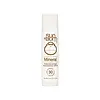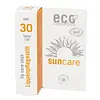What's inside
What's inside
 Key Ingredients
Key Ingredients

 Benefits
Benefits

 Concerns
Concerns

 Ingredients Side-by-side
Ingredients Side-by-side

Zinc Oxide 8%
Cosmetic ColorantPrunus Amygdalus Dulcis Oil
Skin ConditioningSimmondsia Chinensis Seed Oil
EmollientButyrospermum Parkii Butter
Skin ConditioningCera Alba
EmollientEuphorbia Cerifera Wax
Argania Spinosa Kernel Oil
EmollientCaprylic/Capric Triglyceride
MaskingTocopheryl Acetate
AntioxidantCopernicia Cerifera Wax
Tocopherol
AntioxidantGlycine Soja Oil
EmollientGlyceryl Caprylate
EmollientBisabolol
MaskingPolyhydroxystearic Acid
EmulsifyingPolyglyceryl-3 Oleate
EmulsifyingIsostearic Acid
CleansingLecithin
EmollientGlyceryl Undecylenate
EmollientZinc Oxide 8%, Prunus Amygdalus Dulcis Oil, Simmondsia Chinensis Seed Oil, Butyrospermum Parkii Butter, Cera Alba, Euphorbia Cerifera Wax, Argania Spinosa Kernel Oil, Caprylic/Capric Triglyceride, Tocopheryl Acetate, Copernicia Cerifera Wax, Tocopherol, Glycine Soja Oil, Glyceryl Caprylate, Bisabolol, Polyhydroxystearic Acid, Polyglyceryl-3 Oleate, Isostearic Acid, Lecithin, Glyceryl Undecylenate
Pongamia Glabra Seed Oil
Skin ConditioningCera Alba
EmollientTheobroma Cacao Seed Butter
EmollientButyrospermum Parkii Butter
Skin ConditioningTitanium Dioxide
Cosmetic ColorantRicinus Communis Seed Oil
MaskingCopernicia Cerifera Cera
EmollientPolyglyceryl-3 Polyricinoleate
EmulsifyingHydrogenated Coco-Glycerides
EmollientHippophae Rhamnoides Oil
EmollientCocos Nucifera Oil
MaskingPunica Granatum Seed Oil
EmollientSqualane
EmollientPrunus Persica Fruit Extract
AbrasiveStearic Acid
CleansingAlumina
AbrasiveAroma
Tocopherol
AntioxidantPongamia Glabra Seed Oil, Cera Alba, Theobroma Cacao Seed Butter, Butyrospermum Parkii Butter, Titanium Dioxide, Ricinus Communis Seed Oil, Copernicia Cerifera Cera, Polyglyceryl-3 Polyricinoleate, Hydrogenated Coco-Glycerides, Hippophae Rhamnoides Oil, Cocos Nucifera Oil, Punica Granatum Seed Oil, Squalane, Prunus Persica Fruit Extract, Stearic Acid, Alumina, Aroma, Tocopherol
 Reviews
Reviews

Ingredients Explained
These ingredients are found in both products.
Ingredients higher up in an ingredient list are typically present in a larger amount.
This ingredient is also known as shea butter. It is an effective skin hydrator and emollient.
Emollients help soothe and soften your skin. It does this by creating a protective film on your skin. This barrier helps trap moisture and keeps your skin hydrated. Emollients may be effective at treating dry or itchy skin.
Shea butter is rich in antioxidants. Antioxidants help fight free-radicals, or molecules that may harm the body. It is also full of fatty acids including stearic acid and linoleic acid. These acids help replenish the skin and keep skin moisturized.
While Shea Butter has an SPF rating of about 3-4, it is not a sunscreen replacement.
Shea butter may not be fungal acne safe. We recommend speaking with a professional if you have any concerns.
Learn more about Butyrospermum Parkii ButterCera alba is beeswax, or the wax used by bees to make honeycombs. It is a texture-enhancer and emollient. A study from 2003 found beeswax to be a stronger emollient than ingredients such as petroleum jelly.
As an emollient, beeswax helps hydrate the skin by creating a barrier on top. This barrier traps moisture in.
Emulsifiers help prevent ingredients from separating. This helps create consistent texture.
The structure of beeswax is mainly long-chain alcohols and the esters of fatty acids.
There are three types of beeswax: yellow, white, and absolute. Yellow is pure beeswax taken from the honeycomb. White beeswax is created by filtering or bleaching yellow beeswax. Absolute beeswax is created by treating beeswax with alcohol. Beeswax used in cosmetics are purified.
Beeswax has been used throughout history and even in prehistoric times. Some common uses for beeswax still used today are making candles, as a waterproofing agent, and polish for leather.
Learn more about Cera AlbaTocopherol (also known as Vitamin E) is a common antioxidant used to help protect the skin from free-radicals and strengthen the skin barrier. It's also fat soluble - this means our skin is great at absorbing it.
Vitamin E also helps keep your natural skin lipids healthy. Your lipid skin barrier naturally consists of lipids, ceramides, and fatty acids. Vitamin E offers extra protection for your skin’s lipid barrier, keeping your skin healthy and nourished.
Another benefit is a bit of UV protection. Vitamin E helps reduce the damage caused by UVB rays. (It should not replace your sunscreen). Combining it with Vitamin C can decrease sunburned cells and hyperpigmentation after UV exposure.
You might have noticed Vitamin E + C often paired together. This is because it is great at stabilizing Vitamin C. Using the two together helps increase the effectiveness of both ingredients.
There are often claims that Vitamin E can reduce/prevent scarring, but these claims haven't been confirmed by scientific research.
Learn more about Tocopherol